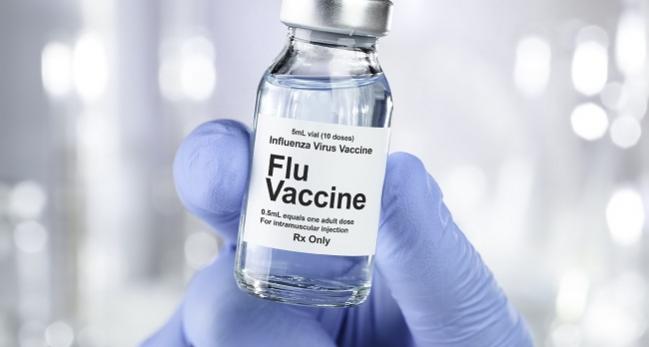IAMI: Influenza Vaccine Beneficial for Post-MI Patients
Hit hard by COVID-19, the study lacked power, but it still shows influenza vaccination could save lives if given to MI patients.

(UPDATED) Patients hospitalized for myocardial infarction who are later vaccinated against influenza have a lower risk of all-cause mortality, MI, or stent thrombosis in follow-up at 1 year, according to results from the Influenza Vaccination After Myocardial Infarction (IAMI) trial.
In this study, which was presented during the final Hot Line session at the European Society of Cardiology Congress 2021, the primary outcome of all-cause mortality, MI, or stent thrombosis occurred in 5.3% of 1,272 patients who were vaccinated against the flu and 7.2% of 1,260 patients who received a placebo (HR 0.72; 95% CI 0.52-0.99).
“The findings,” said lead investigator Ole Fröbert, MD, PhD (Örebro University, Sweden), “suggest that influenza vaccination saves lives and should be considered as part of in-hospital treatment after MI.” Given their results, all patients with cardiovascular disease should get their annual flu shot, he added.
“We were testing does this work, and our findings—the hazard ratio that came out, even though we didn’t enroll the anticipated number of patients—was more or less exactly what was prespecified in our power calculation,” said Fröbert. “The effect size was also the same as has been seen in small, single-center randomized trials—there are three such trials published—and the same effect size seen in meta-analyses, including observational data.”
Jacob Udell, MD (University of Toronto, Canada), who was involved in the INVESTED trial testing a high-dose influenza vaccine against a low-dose vaccine in high-risk CVD patients, was disappointed the DSMB halted IAMI, noting that many clinical trials have had to push through with recruitment even in the midst of the pandemic. Still, he’s sympathetic and said he understands their reasoning.
Although the relative 28% reduction in the primary endpoint “looks great,” Udell said, investigators got lucky to a certain extent given the study’s lack of power. “The results aren’t definitive but still very exciting,” he told TCTMD. “Personally, I already think we have enough evidence to say that [vaccination] is something we should be doing at discharge [for MI patients]. I absolutely think that this trial, within the totality of evidence, is consistent with the signal for benefit.”
In 2013, JAMA published a meta-analysis, led by Udell, of the existing trials at that time, including FLUVACS and FLUCAD, among others, that reported the influenza vaccine was associated with a lower risk of major adverse cardiovascular events, a benefit that was particularly pronounced among the highest-risk patients, such as those with ACS.
Vaccine in the Hospital Equals Better Compliance
Patients were eligible for IAMI if they had a STEMI or NSTEMI and had undergone coronary angiography or PCI. To facilitate enrollment, patients with stable coronary artery disease 75 years or older with at least one additional risk factor were included in the trial, but they made up a very small percentage of the study (0.3%).
Over 12 months of follow-up, all-cause mortality occurred in 2.9% and 4.9% of the vaccine- and placebo-treated patients (HR 0.59; 95% CI 0.39-0.89). Similarly, rate of cardiovascular death also favored vaccination (2.7% vs 4.5%; HR 0.59; 95% CI 0.39-0.90). There was no statistically significant difference in the rate of MI, with 2.0% and 2.4% of patients in the vaccine and placebo arms having an event, nor was there a difference in the rate of stent thrombosis.
As part of their study, Fröbert and colleagues conducted an exploratory meta-analysis to further investigate the effects of vaccination on cardiovascular death. Combining IAMI with FLUVACS, FLUCAD, and a 2011 study led by Arintaya Phrommintikul, MD (Chiang Mai University, Thailand), they observed a significant 49% reduction in the risk of cardiovascular death among vaccine-treated patients compared with those who received placebo.
Barbara Casadei, MD, DPhil (University of Oxford, England), the discussant following the Hot Line presentation, pointed out that cardiovascular disease and influenza are two leading causes of hospitalization and mortality and that they share a reciprocal relationship. Regarding the reduction in cardiovascular mortality, she asked what might be the reason for the benefit with vaccination, noting there was no reduction in the risk of MI among vaccinated patients.
In response, Fröbert said that IAMI was a pragmatic trial and while all the clinical events were adjudicated, they don’t have data on the types of cardiovascular death.
For Casadei, although the mechanism might still be unknown, it’s irrelevant to the bigger public health message. “The deployment of the influenza vaccination in high-risk patients with cardiovascular disease is useful,” she said. “For those interested in mechanisms, we still don’t know why it works, whether it is a specific effect on cardiovascular events or whether it is protecting high-risk patients. It doesn’t really matter that much. The message from public health is that vaccination should be applied by risk, and age is part of that risk, but not [the only factor]. High-risk patients should be vaccinated, and we need to vaccinate where we can. If they present to the hospital, they should be vaccinated there.”
In the trial, 13.2% of patients in the placebo arm crossed over to the vaccination group, which, if anything, investigators say might have biased the results towards the null. Although patients in the intervention arm of the trial were allowed to obtain the influenza vaccine on their own after being enrolled in the study, the IAMI group believes that in-hospital influenza vaccination after MI would be a better approach, if this strategy gets traction.
Asked about clinical practice, Fröbert said the influenza vaccination is recommended in the European and US guidelines (class I, level of evidence B) for the secondary prevention of CVD, though physicians don’t always follow the advice.
“In some hospitals, they take it seriously, but it’s not a lot of hospitals,” he said. “One of the messages from this study is that if you incorporate influenza vaccination as part of routine care after myocardial infarction, at least during influenza season, you will ensure high compliance and you will ensure an effect.”
Udell said the INVESTED researchers are in discussions with the IAMI investigators, as well as others conducting the Influenza Vaccine to Prevent Adverse Vascular Events (IVVE) study, to perform a meta-analysis of the randomized controlled data. Like IAMI, INVESTED was stopped early, although for futility given that there was no difference between the two vaccine doses for the primary CVD endpoint. INVESTED included a broader patient population compared with IAMI as investigators enrolled not only post-MI patients but also those with a hospitalization for heart failure with the past 2 years.
“If there is a silver lining to this terrible year and a half that everybody has suffered, I think it’s that the impact of respiratory tract infections on cardiovascular health is certainly propagated to the surface more than it ever has before,” said Udell. “A lot more people are starting to appreciate it, and I think IAMI will catch a lot of people’s attention.”
Michael O’Riordan is the Managing Editor for TCTMD. He completed his undergraduate degrees at Queen’s University in Kingston, ON, and…
Read Full BioSources
Fröbert O, Götberg M, Erlinge D, et al. Influenza vaccination after myocardial infarction: a randomized, double-blind, placebo-controlled, multicenter trial. Circulation. 2021;Epub ahead of print.
Disclosures
- Fröbert reports grant support from Sanofi Pasteur.





Comments